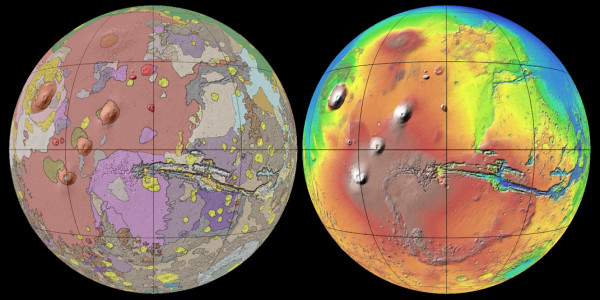
The high-resolution map showcases in vivid color the planet's geologic terrain. Scientists expect it to offer clues to the geologic processes that shaped the red planet's barren, windswept landscape as well as to guide any future human expeditions.
Humans have been sending robotic emissaries to our neighbor for more than five decades now, but only since the 1990s have orbiters had the ability to map out the minerals, water, and subsurface geology of Mars. The oldest regions of the planet, nearly four billion years old, are colored dark brown. The youngest areas are colored orange and red.
"The new Mars global geologic map will provide geologic context for regional and local scientific investigations for many years to come," said USGS acting director Suzette Kimball in a statement.
"Findings from the map will enable researchers to evaluate potential landing sites for future Mars missions that may contribute to further understanding of the planet's history."
The new Mars map can be downloaded for free on the USGS website.
See for Yourself
Step outside on any clear night this week and you'll be able to clearly see Mars hanging low in the southwest sky. Visible to the naked eye as a bright, orange-hued star, the planet appears next to a true star, the blue-white Spica.
The distance between the red planet and Earth varies widely, but the average is 140 million miles (225 million kilometers). That's so far away that sunlight reflecting off its ruddy surface takes an average of 12.5 minutes to hit our eyes.
Train your backyard telescope on the planet, and high magnification will reveal a few surface features. Because of its orbital position relative to the sun and Earth, Mars is not fully illuminated - only about 87 percent of it is lit. So instead of being a round disk, it has the shape of a miniature gibbous moon.
One feature that will surely catch your eye is the frosty north polar cap. Consisting of frozen water and frozen carbon dioxide (or dry ice), the caps glow bright white, and they're conspicuous because the planet's northern hemisphere is now tilted some 23 degrees toward Earth. Though the planet through a telescope is still small, with practice your eye will begin to pick out subtle details of its soft surface features.
A small backyard scope with at least a four-inch mirror will reveal a pattern of light and dark shadings similar to those seen on our moon. Now that handy up-to-date maps are available online, it's possible to identify a variety of features.
Enjoy your trip to Mars.



Reader Comments
to our Newsletter